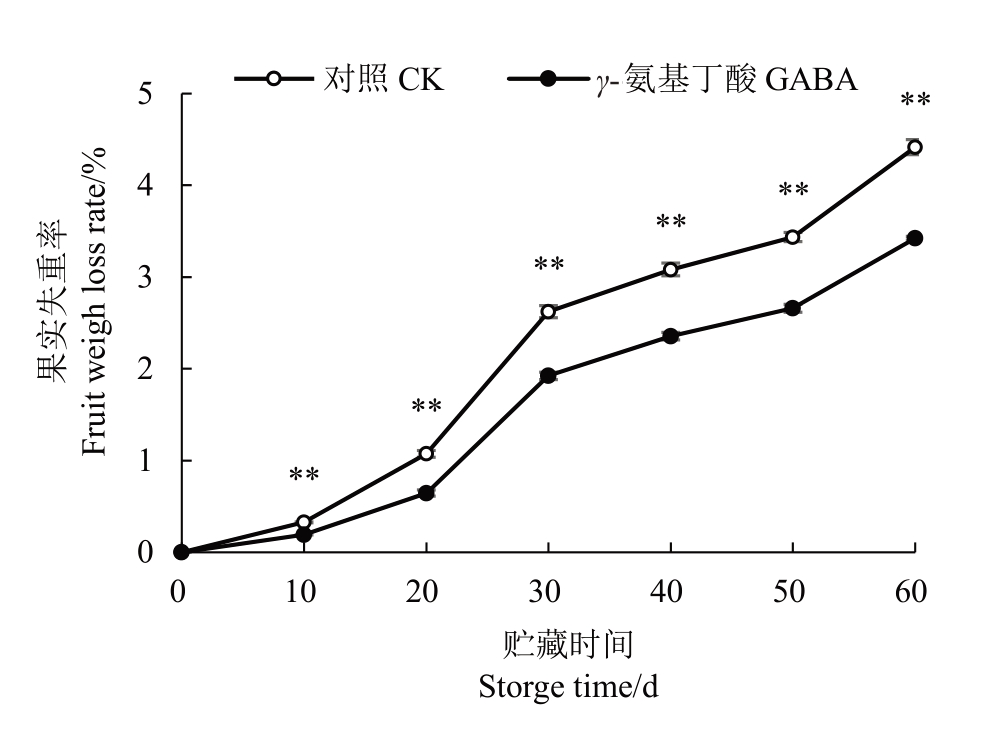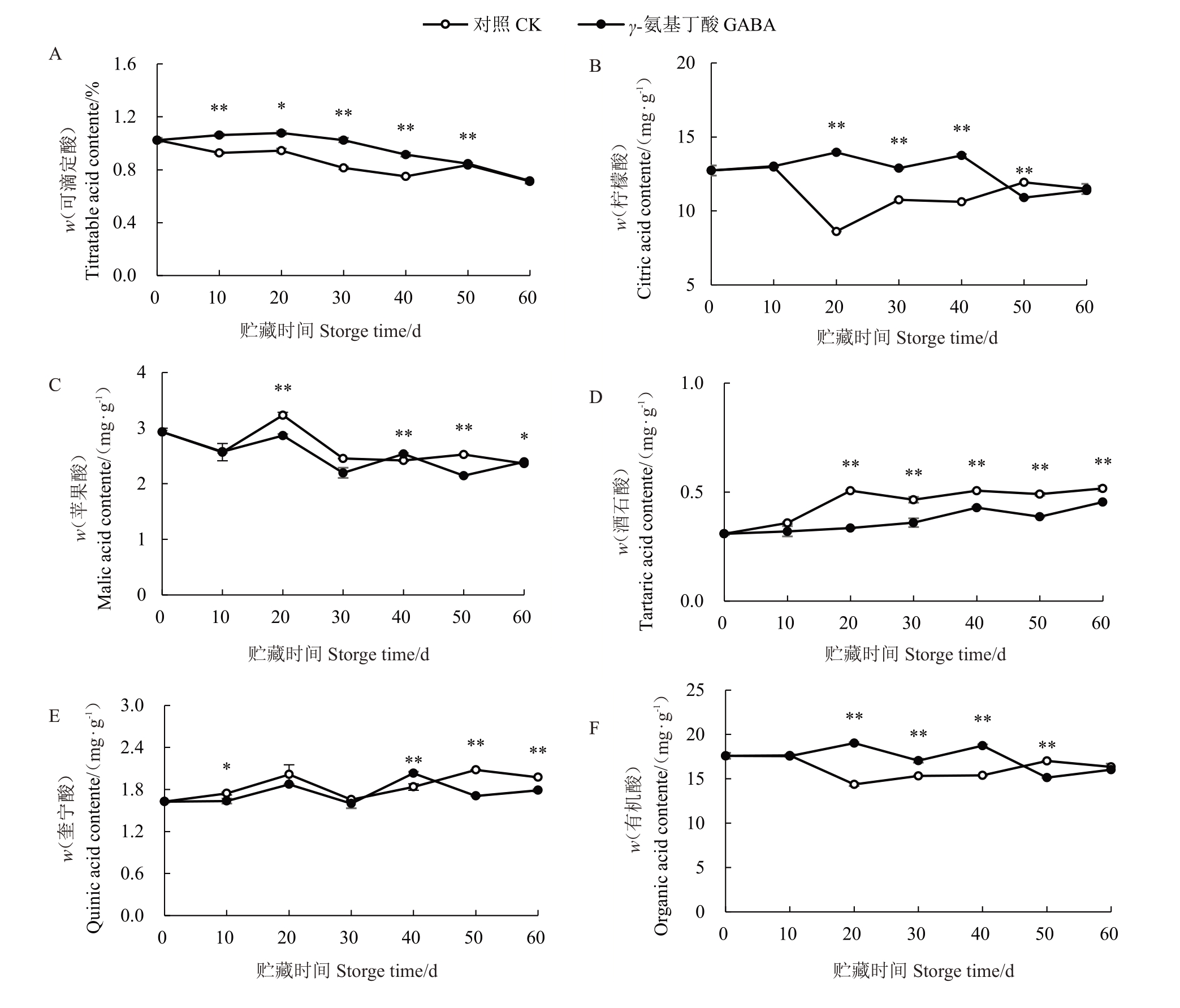柑橘在我国占有重要的经济地位,因风味独特、富含营养物质而广受欢迎。靖安椪柑是江西省名特优柑橘品种,被称为“远东橘王”,具有果形美、色泽艳、汁多渣少、风味香甜、耐贮藏、成熟晚等特点,已成为靖安地区果农经济收入的重要来源[1]。然而,靖安椪柑生产具有很强的季节性,果实成熟期集中,采后贮藏存在果实糖和有机酸的减少、浮皮以及组织细胞的氧化损伤等问题[2-4],从而造成品质劣变,给当地果农造成较大的经济损失。采后贮藏保鲜是柑橘生产中重要环节之一,目前,柑橘果实主要通过咪鲜胺、2,4-D等化学保鲜剂和热处理、辐照技术等物理措施[5-7]进行采后贮藏保鲜,然而,热处理等物理措施虽然绿色环保,但成本较高,而化学保鲜剂又存在农药残留威胁人体健康和环境安全问题[8]。随着人们对食品安全关注的日益增强,近年来如何利用高效安全的外源信号物质调控果实采后贮藏品质已成为研究热点。
γ-氨基丁酸(γ-aminobutyric acid,GABA),也称γ-氨基酸,广泛存在于植物体内[9]。大量研究证明,GABA 通过提高光合作用、调控活性氧(ROS)代谢以及激活抗氧化酶等途径提高植物的抗逆性,与植物抗氧化系统密切相关[10]。外源GABA可显著提高盐胁迫下番茄嫁接苗SOD、POD 和CAT 活性[11],亦可促进热胁迫下茶树多酚积累,诱导POD、CAT 和APX 活性增强[12]。另有研究表明,外源GABA 处理后能显著提高桃[13]和香蕉[14]等果实内源GABA的含量,从而提高果实的耐冷性,亦可激发血橙SOD、POD、APX 和谷胱甘肽还原酶(GR)活性,抑制丙二醛(MDA)含量的上升,有效缓解低温胁迫膜脂过氧化伤害[15]。此外,GABA还影响果实采后有机酸代谢从而调控果实贮藏品质,苹果经10 mmol·L-1 GABA处理可显著延缓可滴定酸和苹果酸的损失,并增加琥珀酸和草酸的含量[16];外源GABA 处理能够抑制夏橙和纽荷尔脐橙果实贮藏期柠檬酸降解相关基因表达,有效减缓柠檬酸含量降解,改善果实的贮藏品质[17]。
笔者项目组前期研究(数据未发表)发现0.5~5.0 mmol·L-1外源GABA 处理能有效提高柑橘采后果实品质和贮藏性能,其中0.5 mmol·L-1处理效果最佳。笔者旨在进一步探索0.5 mmol·L-1外源GABA 处理对靖安椪柑果实贮藏过程中的品质变化和抗氧化能力的影响,进一步阐明其生理调节机制,从而为GABA 应用于柑橘果实采后贮藏保鲜与品质调控提供理论依据。
1 材料和方法
1.1 材料和处理
靖安椪柑果实于2019年11月17日采自江西省靖安县果业局下属果园,当天运回江西农业大学江西省果蔬保鲜与无损检测重点实验室,发汗2 d后,选择中等大小、色泽一致、无病虫害及物理损伤的果实,采用0.5 mmol·L-1GABA浸果2 min,以清水浸泡为对照,3 次重复,每重复200 个果实。自然晾干后单果装聚乙烯袋(18 cm×14 cm×5 μm),置人工气侯室(室温20±1 ℃,RH 95±2%)贮藏60 d。取20个果实固定测量失重率和色差指数,每10 d取15个果实测定果实品质指标,并取部分果皮和果肉用液氮速冻,保存于-80 ℃,用于后续指标测定。
1.2 色差指数测定
采用日本柯尼卡美能达可携式色差计(CR-400)。每处理测定20个果实,每果随机均匀取果实赤道部4 个点测定a*值(红绿色差:正值为红色,负值为绿色)、b*值(黄蓝色差:正值为黄色,负值为蓝色)和L*值(亮度),按以下公式计算柑橘色差指数(CCI):CCI=1000×a*/(L*×b*)。
1.3 失重率测定
每个处理选取20个果实,每10 d称量其单果质量,计算失重率,失重率/%=(贮前质量-贮后质量)/贮前质量×100。
1.4 可滴定酸和可溶性固形物含量测定
采用酸碱中和滴定法测定可滴定酸(Titratable acid,TA)含量[18],结果以柠檬酸的量换算;采用RA-250WE 手持数字糖度计测定可溶性固形物(Total soluble solids,TSS)含量。每处理3次重复。
1.5 可溶性糖和有机酸含量提取与测定
果实可溶性糖和有机酸含量提取与测定参照高阳等[1]的方法,采用高效液相色谱法(HPLC)测定其组分含量。
1.6 抗氧化酶活性和H2O2含量测定
参照曹建康等[18]的方法,过氧化氢酶(CAT)和抗坏血酸过氧化物酶(APX)活性采用紫外比色法测定;过氧化物酶(POD)活性采用愈创木酚法测定,酶活性单位以U·g-1·min-1 表示。超氧化物歧化酶(SOD)活性和H2O2含量采用试剂盒(南京建成生物工程研究所)测定,酶活性单位以U·g-1表示,H2O2含量结果表示为μmol·g-1。
1.7 酚类物质含量和羟自由基清除率测定
样品研磨后称取0.5 g,加入10 mL 无水甲醇摇匀,在50 ℃下超声辅助提取30 min,于5000 r·min-1离心15 min,重复提取3 次后混合上清液定容至30 mL,用于总酚、类黄酮含量和羟基自由基清除率测定,总酚、类黄酮含量(w,后同)以mg·g-1表示,羟基自由基清除率结果以清除百分率表示[18-20]。
1.8 数据统计与分析
试验采用完全随机设计,使用Excel 2016 进行数 据 统 计,用Graph Pad Prism8.0 和Excel 2016 作图,用SPSS20.0 统计软件进行显著性差异分析:显著(p <0.05)、极显著(p <0.01)。
2 结果与分析
2.1 GABA 处理对靖安椪柑果实失重率和色差指数的影响
由图1 可知,靖安椪柑果实经GABA 处理后在60 d贮藏期间,果实的失重率呈现上升的趋势,在贮藏10~60 d 对照组的失重率均高于GABA 处理组,差异极显著。

图1 GABA 处理对靖安椪柑失重率的影响
Fig.1 Effects of GABA treatment on weight loss rate of Jing’an ponkan fruit
*表示GABA 处理与对照存在显著差异(p <0.05),**表示GABA 处理与对照存在极显著差异(p <0.01)。下同。
* indicates significant difference between GABA treatment and control (p <0.05), and ** indicates extremely significant difference between GABA treatment and control(p <0.01).The same below.
由图2-A 和图2-B 可知,果皮CCI 与果皮a*的变化趋势一致,随着贮藏时间的延长呈现不断上升的趋势,且GABA 处理与对照果实间无显著差异。果皮b*值如图2-C 所示,在贮藏前期GABA 处理组显著高于CK组,但贮藏30 d后,GABA处理组显著低于对照组。果皮的L*值如图2-D 所示,在整个贮藏期呈现先上升后下降的趋势,且GABA处理能维持果实贮藏前期更高的亮度。

图2 GABA 处理对靖安椪柑色差的影响
Fig.2 Effects of GABA treatment on CCI of Jing’an ponkan fruit
2.2 GABA 处理对靖安椪柑果实可溶性固形物含量的影响
如图3 所示,椪柑果实采摘时TSS 含量为13.0%,随着贮藏时间直至50 d 都呈不断上升的趋势,在贮藏60 d 时,TSS 含量呈现下降的趋势,且GABA 处理组和对照组分别下降了0.9%和1.5%。在贮藏期60 d 内,GABA 处理组TSS 含量均高于对照组,但两者没有差异。

图3 GABA 处理对靖安椪柑可溶性固形物含量的影响
Fig.3 Effects of GABA treatment on TSS of Jing’an ponkan fruit
2.3 GABA 处理对靖安椪柑果实可溶性糖含量的影响
从图4可知,在靖安椪柑果实贮藏过程中,总糖(图4-A)和蔗糖(图4-D)含量随贮藏期的延长呈上升的趋势,果糖(图4-B)含量比较稳定,葡萄糖(图4-C)含量总体呈下降趋势。靖安椪柑果实中蔗糖的含量较高(37.38~44.07 mg·g-1),其次是果糖(23.68~27.34 mg·g-1)和葡萄糖(20.64~27.58 mg·g-1)。GABA 处理组的总糖、果糖、葡萄糖与对照组相比在贮藏10~30 d 都维持在更高的水平,且存在极显著性的差异,GABA 处理组与对照组相比在贮藏10、20和30 d的蔗糖含量分别提高了6.42、3.32、5.60 mg·g-1,果糖含量分别提高了1.83、1.63、2.39 mg·g-1,葡萄糖含量分别提高了3.79、1.05、3.54 mg·g-1。

图4 GABA 处理对靖安椪柑可溶性糖含量的影响
Fig.4 Effects of GABA treatment on soluble sugars content of Jing’an ponkan fruit
2.4 GABA 处理对靖安椪柑果实可滴定酸和有机酸含量的影响
靖安椪柑可滴定酸含量(图5-A)随贮藏时间的延长呈下降的趋势,在贮藏10~40 d,GABA 处理组果实TA 含量极显著高于对照组,两组果实TA 含量分别是1.06%、1.08%、1.02%、0.91%和0.93%、0.94%、0.81%、0.75%。

图5 GABA 处理对靖安椪柑可滴定酸和有机酸的影响
Fig.5 Effects of GABA treatment on TA and organic acids content of Jing’an ponkan fruit
由图5-B 可知,靖安椪柑柠檬酸含量在整个贮藏期间呈下降的趋势,在贮藏20~40 d 时,GABA 处理组的柠檬酸含量极显著高于对照组,这与可滴定酸(图5-A)和有机酸(图5-F)含量的变化趋势一致,但贮藏50~60 d GABA处理与对照无显著差异。苹果酸含量(图5-C)在果实贮藏期间总体呈下降趋势,而奎宁酸含量(图5-E)反之。在贮藏40 d时GABA 处理组苹果酸和奎宁酸含量均极显著高于对照组,而GABA 处理组酒石酸含量(图5-D)在贮藏期20~60 d均显著低于对照组。
2.5 GABA 处理对靖安椪柑果实抗氧化酶活性的影响
GABA处理靖安椪柑果实的CAT活性(图6-A)与对照组相比,贮藏20 d 时维持在更高水平,贮藏30 d、40 d时存在极显著差异。APX活性(图6-B)在贮藏期内呈上升的趋势,且GABA处理组靖安椪柑果实除在贮藏10 和60 d 时的APX 活性极显著高于对照组,其他均低于对照果实。GABA 处理果实POD 活性(图6-C)呈先上升后下降的趋势,而对照组则波动比较大,除了在贮藏期20 d 和60 d 对照组显著高于GABA 处理外,其他时间均极显著低于GABA 处理组。在整个贮藏期间,GABA 处理组SOD 活性(图6-D)均高于对照组,在10、30 和60 d差异达显著水平,GABA 处理组分别是CK 组的1.18、1.15和1.05倍。

图6 GABA 处理对靖安椪柑抗氧化酶活性的影响
Fig.6 Effects of GABA treatment on antioxidant enzyme activity of Jing’an ponkan fruit
2.6 GABA 处理对靖安椪柑H2O2、总酚、类黄酮含量和羟自由基清除率的影响
靖安椪柑果实贮藏期间H2O2含量变化如图7-A所示,GABA 处理组在贮藏30 d 和40 d 极显著低于对照组而在50 d 和60 d 极显著高于对照组;总酚含量逐渐增加,GABA 处理组在贮藏10、50 和60 d 显著高于对照,但在30 d 和40 d 相反(图7-B)。在整个贮藏期间,GABA 处理组类黄酮含量均高于对照组,且在贮藏10、30和60 d达到显著差异水平(图7-C)。由图7-D可知,除40 d外,GABA处理组羟自由基清除率均高于对照组果实,且在10 d 时两者差异达显著水平。

图7 GABA 处理对靖安椪柑H2O2、总酚、类黄酮含量和羟自由基清除率的影响
Fig.7 Effects of GABA treatment on H2O2,total phenols,flavonoid content and hydroxyl radical scavenging rate of Jing’an ponkan fruit
3 讨 论
果实色泽是影响外观品质重要指标之一,且与商品价值密切相关[21]。研究表明,在果蔬采后贮藏过程中,GABA处理都能够使果蔬有更好的色泽,维持更高的品质。在黄秋葵中GABA 能增加叶绿素的积累而降低黄化现象[22]。Sheng 等[17]研究表明GABA处理后纽荷尔脐橙果实a*值显著增大,果皮颜色更早由橘色变为红色。GABA处理保持桃果肉较高的亮度(L*值)和色调角度(H°值),从而降低其褐变率,减缓桃果实冷害的发生[13]。本研究表明GABA 处理能延缓靖安椪柑在贮藏过程中果皮转黄,维持光泽。此外,由于采后果实呼吸消耗和蒸腾失水,导致果实失重率增加[23],GABA处理也能有效降低果实失重率的上升,维持果实贮藏品质。
果实内在品质指标主要包括TSS、TA、Vc 和糖酸含量等。TSS是评判果实成熟度和内在品质变化的主要指标,它包括果实的糖、酸和Vc 等多种物质[24]。本试验中,GABA 处理能维持靖安椪柑果实较高水平的TSS,从而维持果实贮藏品质。目前,利用HPLC测定糖酸组分含量进行风味品质的综合评价,在柑橘[25]、苹果[26]、梨[27]上等已有较多研究。柑橘果实可溶性糖主要是果糖、葡萄糖和蔗糖,而不同柑橘品种其独有风味由上述3 种糖不同比例所决定[25]。本研究结果表明靖安椪柑果实蔗糖含量最高,占总糖含量的40.18%~46.54%,其次是果糖28.27%~30.01%、葡萄糖22.65%~29.52%,GABA 处理能显著提高椪柑果实果糖和葡萄糖含量。果实的酸味主要来自有机酸,其含量是决定风味和果实品质的重要指标,柑橘果实有机酸积累以柠檬酸为主[28],GABA 途径为其降解的重要代谢通路之一。已有研究表明,外源GABA 处理抑制脐橙果实GABA途径谷氨酸脱羧酶基因表达,从而促进柠檬酸的含量显著增加,同时氨基酸也得到积累,说明GABA在果实柠檬酸降解及氨基酸合成中起着重要的调控作用[17],本研究结果与此类似,GABA处理能使靖安椪柑果实柠檬酸、总有机酸和可滴定酸(TA)含量维持在更高的水平。
果实在衰老过程中会引起组织细胞的氧化损伤及活性氧的紊乱。O2-和H2O2是两类重要的活性氧物质,过量积累时对细胞具有极强的毒害作用,容易造成组织的氧化损伤,加速果实的衰老,抗氧化酶(SOD、POD、CAT、APX)和抗氧化物质(AsA 和GSH)是清除活性氧的重要力量[29-30]。本试验中,GABA 处理组靖安椪柑果实SOD、POD、CAT、APX活性比对照组活性强,与盘柳依等[31]和陈存坤等[32]在猕猴桃和草莓果实采后抗氧化酶活性研究结果类似,但抗氧化酶活相关基因表达需要更进一步研究。羟自由基是氧自由基中最活泼和不稳定的自由基[33],抗氧化酶系统有效清除逆境胁迫对植物体内积累的过量活性氧,使植物细胞内自由基维持在一个低水平,防止自由基的毒害[34]。本试验GABA 处理组的羟自由基清除率在贮藏40 d 内高于对照组,减轻了果实羟自由基的毒害。在果实贮藏20~40 d时H2O2含量低于对照组,说明GABA处理能在果实贮藏前中期减轻H2O2的毒害,但在果实贮藏后期50~60 d时显著高于对照组,可能靖安椪柑果实ROS短暂迅速增加产生的防卫反应从而提高果实抗逆性的能力,与黄艳等[35]的结果类似。
酚类和类黄酮是苯丙烷代谢的主要产物,它们本身具有抑菌作用和提高果实的抗氧化性能[36]。有研究表明,柑橘果实在贮藏后期的总酚和类黄酮物质会因果实衰老和失水而减少[37]。本试验中,GABA处理果实总酚和类黄酮含量在贮藏10、50和60 d时,都高于对照组,且后期呈上升的趋势,说明GABA 处理能在果实贮藏过程中通过提高果实总酚和类黄酮含量从而增强果实抗氧化性能、延缓果实衰老进程。
4 结 论
研究表明,外源GABA 处理能减少靖安椪柑果实的失重率,提高果皮亮度,维持较高的果实TSS、TA 和糖酸含量,从而提高果实采后品质和保鲜效果。此外外源GABA 处理能激发CAT、APX、SOD和POD活性,同时促进总酚、类黄酮含量积累,这可能是外源GABA 处理提高靖安椪柑果实贮藏品质的生理机制。综上所述,适宜浓度的GABA能有效维持柑橘采后贮藏品质和抗氧化性能,为GABA应用于柑橘贮藏保鲜提供了理论依据,但GABA作用机制还需进一步研究。
[1]高阳,阚超楠,陈楚英,陈明,陈金印.‘靖安椪柑’果实发育阶段柠檬酸含量变化及其代谢相关基因的表达分析[J].果树学报,2018,35(8):936-946.GAO Yang,KAN Chaonan,CHEN Chuying,CHEN Ming,CHEN Jingyin.Changes of citric acid content and the related gene expression at different developmental stages of fruits in‘Jing’an ponkan’[J].Journal of Fruit Science,2018,35(8):936-946.
[2]陈小红.采收期、贮藏温度和热水处理对靖安椪柑果实贮藏保鲜效果的研究[D].南昌:江西农业大学,2015.CHEN Xiaohong.Effect of harvest date,storage temperature and hot water treatment on preservation of Jing'an Ponkan[D].Nanchang:Jiangxi Agricultural University,2015.
[3]GAO Y,KAN C N,WAN C P,CHEN C Y,CHEN M,CHEN J Y.Effects of hot air treatment and chitosan coating on citric acid metabolism in ponkan fruit during cold storage[J].Plos One,2018,13(11):0206585.
[4]梁芳菲,王小容,邓丽莉,曾凯芳,姚世响.采后柑橘果实糖酸代谢研究进展[J].食品与发酵工业,2018,44(10):268-274.LIANG Fangfei,WANG Xiaorong,DENG Lili,ZENG Kaifang,YAO Shixiang.Research advances in sugar and acid metabolism of postharvest citrus fruit[J].Food and Fermentation Industries,2018,44(10):268-274.
[5]谢莉,罗焘,许让伟,程运江.柑橘果实贮藏期咪鲜胺和抑霉唑残留量的动态变化[J].华中农业大学学报,2016,35(1):17-23.XIE Li,LUO Tao,XU Rangwei,CHENG Yunjiang.Dynamic analyses of prochloraz and imazalil residues in citrus during fruit storage[J].Journal of Huazhong Agricultural University,2016,35(1):17-23.
[6]祝建,刘本勇,李述举,白芝兰,刘聪,邓晓东,张豫,谢宗周,刘继红.2,4-D 在柑橘果实留树保鲜中的作用和可能机制研究[J].园艺学报,2020,47(11):2086-2094.ZHU Jian,LIU Benyong,LI Shuju,BAI Zhilan,LIU Cong,DENG Xiaodong,ZHANG Yu,XIE Zongzhou,LIU Jihong.Effects of 2,4-D on keeping citrus fruit fresh on tree and the underlying mechanisms[J].Acta Horticulturae Sinica,2020,47(11):2086-2094.
[7]罗梦,赵博,陈浩,黄敏.γ-辐照对椪柑果实保鲜效果的影响[J].食品与机械,2019,35(6):135-138.LUO Meng,ZHAO Bo,CHEN Hao,HUANG Min.Effects of γirradiation on the preservation of Ponkan fruit[J].Food & Machinery,2019,35(6):135-138.
[8]梁攀,李悦妍,黄少云,陈良哲,易庆平.柑橘类水果贮藏保鲜技术研究进展[J].包装工程,2021,42(13):57-66.LIANG Pan,LI Yueyan,HUANG Shaoyun,CHEN Liangzhe,YI Qingping.Research progress of postharvest storage and preservation technology of citrus fruits[J].Packaging Engineering,2021,42(13):57-66.
[9]NGO D H,VO T S.An updated review on pharmaceutical properties of gamma-aminobutyric acid[J].Molecules,2019,24(15):2678.
[10]LI L,DOU N,ZHANG H,WU C X.The versatile GABA in plants[J].Plant Signaling&Behavior,2021,16(3):1862565.
[11]贾邱颖,吴晓蕾,冀胜鑫,诸新培,赵峰,宫彬彬,李敬蕊,高洪波.γ-氨基丁酸对番茄嫁接苗耐盐性的生理调控效应[J].植物营养与肥料学报,2021,27(1):122-134.JIA Qiuying,WU Xiaolei,JI Shengxin,CHU Xinpei,ZHAO Feng,GONG Binbin,LI Jingrui,GAO Hongbo.Physiological regulation of γ-aminobutyric acid on the salt tolerance of grafted tomato seedlings[J].Plant Nutrition and Fertilizer Science,2021,27(1):122-134.
[12]REN T Y,ZHENG P C,ZHANG K X,LIAO J R,XIONG F,SHEN Q,MA Y C,FANG W P,ZHU X J.Effects of GABA on the polyphenol accumulation and antioxidant activities in tea plants (Camellia sinensis L.) under heat-stress conditions[J].Plant Physiology and Biochemistry,2021,159:363-371.
[13]宋春波.外源GABA 和褪黑素减轻桃果实采后冷害的机理研究[D].上海:上海海洋大学,2016.SONG Chunbo.Mechanism study of exogenous γ-aminobutyric acid and melatonin alleviates chilling injury in postharvest peach fruit[D].Shanghai:Shanghai Ocean University,2016.
[14]胡伟,颜彦,徐碧玉,金志强.γ-氨基丁酸对香蕉果实采后成熟的调控作用及其生理机制[J].热带作物学报,2014.35(12):2474-2481.HU Wei,YAN Yan,XU Biyu,JIN Zhiqiang.The effect and physiological mechanism of γ-aminobutyric acid on postharvest banana ripening[J].Chinese Journal of Tropical Crops,2014,35(12):2474-2481.
[15]HABIBI F,RAMEZANIAN A,RAHEMI M,ESHGHI S,GUILLÉN F,SERRANO M,VALERO D.Postharvest treatments with γ-aminobutyric acid,methyl jasmonate,or methyl salicylate enhance chilling tolerance of blood orange fruit at prolonged cold storage[J].Journal of the Science of Food and Agriculture,2019,99(14):6408-6417.
[16]HAN S K,NAN Y Y,QU W,HE Y H,BAN Q Y,LV Y R,RAO J P.Exogenous γ-aminobutyric acid treatment that contributes to regulation of malate metabolism and ethylene synthesis in apple fruit during storage[J].Journal of Agriculture and Food Chemistry,2018,66(51):13473-13482.
[17]SHENG L,SHEN D D,LUO Y,SUN X H,WANG J Q,LUO T,ZENG Y L,XU J,DENG X X,CHENG Y J.Exogenous γ-aminobutyric acid treatment affects citrate and amino acid accumulation to improve fruit quality and storage performance of postharvest citrus fruit[J].Food Chemistry,2017,216:138-145.
[18]曹建康,姜微波,赵玉梅.果蔬采后生理生化实验指导[M].北京:中国轻工业出版社,2007.CAO Jiankang,JIANG Weibo,ZHAO Yumei.Experimental guidance on postharvest physiology and biochemistry of fruits and vegetables[M].Beijing:China Light Industry Press,2007.
[19]张昭.中国地方柚果实酚类物质含量及其抗氧化活性分析[D].重庆:西南大学,2015.ZHANG Zhao.Phenolic compositions and antioxidant capacity of the fruits of chinese local pummelos[D].Chongqing:Southwest University,2015.
[20]林建原,陶志华,朱钐汕.杨梅叶中总黄酮提取工艺及其抗氧化活性研究[J].食品科学,2011,32(20):26-29.LIN Jianyuan,TAO Zhihua,ZHU Shanshan.Extraction and antioxidant activity evaluation of total flavonoids from bayberry(Myrica rubra Sieb.et Zucc.) leaves[J].Food Science,2011,32(20):26-29.
[21]LO’AY A A,DAWOOD H D.Chilling injury,fruit color maturity stages,and antioxidant enzyme activities of lemon'baladi CV'fruits under cold storage stress[J].Scientia Horticulturae,2019,257:108676.
[22]殷菲胧,乔沛,李静,王秀丽,董新红.γ-氨基丁酸对黄秋葵采后品质及生理特性的影响[J].食品工业科技,2020,41(4):259-265.YIN Feilong,QIAO Pei,LI Jing,WANG Xiuli,DONG Xinhong.Effect of GABA on the quality and physiological characteristics of postharvest okra[J].Science and Technology of Food Industry,2020,41(4):259-265.
[23]WANG L,NING T,CHEN X L.Postharvest storage quality of citrus fruit treated with a liquid ferment of Chinese herbs and probiotics[J].Scientia Horticulturae,2019,255:169-174.
[24]陈洪彬,王慧玲,蒋璇靓,陈彩萍,程永强.γ-氨基丁酸处理对冷藏番石榴果实品质和耐冷性的影响[J].食品与发酵工业,2021,47(14):130-136.CHEN Hongbin,WANG Huiling,JIANG Xuanjing,CHEN Caiping,CHENG Yongqiang.Effects of γ-aminobutyric acid treatment on the quality properties and chilling tolerance of guava fruit during cold storage[J].Food and Fermentation Industries,2021,47(14):130-136.
[25]林媚,姚周麟,王天玉,徐阳,徐建国,张伟清.8 个杂交柑橘品种的糖酸组分含量及特征研究[J].果树学报,2021,38(2):202-211.LIN Mei,YAO Zhoulin,WANG Tianyu,XU Yang,XU Jianguo,ZHANG Weiqing.A study on the components and characteristics of sugars and acids in 8 hybrid citrus cultivars[J].Journal of Fruit Science,2021,38(2):202-211.
[26]匡立学,聂继云,李银萍,程杨,沈友明.中国不同地区‘富士’苹果品质评价[J].中国农业科学,2020,53(11):2253-2263.KUANG Lixue,NIE Jiyun,LI Yinping,CHENG Yang,SHEN Youming.Quality evaluation of‘Fuji’apples cultivated in different regions of China[J].Scientia Agricultura Sinica,2020,53(11):2253-2263.
[27]杨盛,白牡丹,郝国伟,张晓伟,杜海燕,高鹏,郭黄萍.‘玉露香’梨果实发育过程中糖、酸积累特性研究[J].果树学报,2019,36(8):1013-1019.YANG Sheng,BAI Mudan,HAO Guowei,ZHANG Xiaowei,DU Haiyan,GAO Peng,GUO Huangping.Study on sugar and organic acid accumulation during fruit development in‘Yuluxiang’pear[J].Journal of Fruit Science,2019,36(8):1013-1019.
[28]卢晓鹏,李菲菲,谢深喜.柑橘果实柠檬酸积累调控基因研究进展[J].果树学报,2018,35(1):118-127.LU Xiaopeng,LI Feifei,XIE Shenxi.Citrate accumulation in citrus fruit:a molecular perspective[J].Journal of Fruit Science,2018,35(1):118-127.
[29]韩多红,王恩军,张勇,路瑞霞,王红霞,王艳.外源γ-氨基丁酸对盐胁迫下菘蓝幼苗活性氧和抗氧化系统的影响[J].北方园艺,2021(6):111-116.HAN Duohong,WANG Enjun,ZHANG Yong,LU Ruixia,WANG Hongxia,WANG Yan.Effects of exogenous γ-aminobutyric acid (GABA) on reactive oxygen species and antioxidant system of Isatis indigotica Fort.seedlings under salt stress[J].Northern Horticulture,2021(6):111-116.
[30]MITTLER R,VANDERAUWERA S,GOLLERY M,BREUSEGEM F V.Reactive oxygen gene network of plants[J].Trends in Plant Science,2004,9(10):490-498.
[31]盘柳依,赵显阳,陈明,付永琦,向妙莲,陈金印.外源茉莉酸甲酯处理对采后猕猴桃果实品质和抗氧化酶活性的影响[J].食品与发酵工业,2019.45(9):190-196.PAN Liuyi,ZHAO Xianyang,CHEN Ming,FU Yongqi,XIANG Miaolian,CHEN Jinyin.Effects of exogenous methyl jasmonate on fruit qualities and antioxidases activities of postharvest kiwifruits[J].Food and Fermentation Industries,2019,45(9):190-196.
[32]陈存坤,张慧杰,纪海鹏,张晓军,董成虎,张娜,于晋泽,王文生,薛文通.臭氧精准处理提高采后草莓抗氧化酶活性和酚类物质含量[J].农业工程学报,2019,35(10):282-288.CHEN Cunkun,ZHANG Huijie,JI Haipeng,ZHANG Xiaojun,DONG Chenghu,ZHANG Na,YU Jinze,WANG Wensheng,XUE Wentong.Ozone treatment improving antioxidant enzyme activity and phenolic content of postharvest strawberry[J].Transactions of the Chinese Society of Agricultural Engineering,2019,35(10):282-288.
[33]付龙威,汤晓娟,林祥娜,张艳珍,刘云国.枇杷酵素自然发酵过程中有机酸及其抗氧化活性的研究[J].食品研究与开发,2021,42(4):42-47.FU Longwei,TANG Xiaojuan,LIN Xiangna,ZHANG Yanzhen,LIU Yunguo.Studies on the organic acid and antioxidant activity of loquat enzyme during spontaneous fermentation process[J].Food Research and Development,2021,42(4):42-47.
[34]钱金晶,茹珊,张帆,田晓江,李蕾,金日光.茶叶清除羟自由基的能力与其高分子活性中心元素群子参数之间的关系[J].北京化工大学学报(自然科学版),2010,37(1):36-41.QIAN Jinjing,RU Shan,ZHANG Fan,TIAN Xiaojiang,LI Lei,JIN Riguang.The relationship between the distribution of the polymer active center elements and radical scavenging activity in tea[J].Journal of Beijing University of Chemical Technology(Natural Science Edition),2010,37(1):36-41.
[35]黄艳,明建,邓雨艳,邓丽莉,张昭其,曾凯芳.壳寡糖诱导柑橘果实抗病作用中的活性氧变化[J].食品科学,2009,30(22):344-349.HUANG Yan,MING Jian,DENG Yuyan,DENG Lili,ZHANG Zhaoqi,ZENG Kaifang.Induction of Colletotrichum gloeosporioides Penz.resistance through oligochitosan treatment and active oxygen change in citrus fruits[J].Food Science,2009,30(22):344-349.
[36]张静荣,王斌,姜红,王毅,李雪,司敏,李永才,毕阳.采后苯丙噻重氮处理促进梨果实的愈伤[J].食品科学,2018,39(9):190-195.ZHANG Jingrong,WANG Bin,JIANG Hong,WANG Yi,LI Xue,SI Min,LI Yongcai,BI Yang.Postharvest Benzothiadiazole treatment promotes wound healing in pear fruits[J].Food Science,2018,39(9):190-195.
[37]敖淼,李福香,赵吉春,李富华,曾凯芳,明建.柑橘在贮藏加工过程中酚类化合物的变化[J].食品与发酵工业,2019,45(9):282-288.AO Miao,LI Fuxiang,ZHAO Jichun,LI Fuhua,ZENG Kaifang,MING Jian.Variations in phenolic compounds in citrus during storage and processing[J].Food and Fermentation Industries,2019,45(9):282-288.